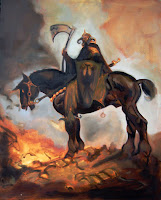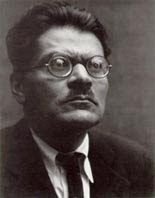Art is the only way to run away without leaving home.
Twyla Tharp
Saturday, October 17, 2009
Monday, October 12, 2009
Gamblin Oil Painting Medium Notes
Alkali Refined Linseed Oil - Processed from flax seeds. This linseed is the purest and lightest industrially produced variety.
Cold Pressed Linseed Oil - Made from the first pressing of flax seeds without heat or chemicals of any kind.
Cold Wax - Made from natural white unbleached beeswax. Mix directly into colors. Cold Wax creates an ultra-thick, matte impasto. For greater shine and flexibility mix with Galkyd medium.
"G-Gel" - Made from alkyd resin, Galkyd Gel is a colorless oil color additive that accelerates the drying rate of oil colors and enables artists to create thick transparent paintings with a moderate sheen.
Galkyd Painting Medium - Alkyd based resin painting medium that thins oil paints and maintains a strong flexible paint film. Galkyd speeds the drying rate and is excellent for glazing providing an enamel like finish. Thins with Turpenoid.
Galkyd Painting Medium Lite No.2 - This low viscosity alkyd resin painting medium is a good replacement for traditional damar/ linseed oil/ turpentine combination mediums. It will give you longer working time and it will maintain your brush strokes. Thins with Turpenoid.
Galkyd Slow Drying Medium - Especially formulated to thin oil colors and give painters extended working time. To use mix equal portions of medium with oil colors to paint wet for at least a day. Since this product should not be diluted you may want to purchase the larger size.
Gamsol - Quality solvent and medium and for general oil painting. Gamsol is also an excellent studio and brush cleaner.
Gamvar - Conservation quality varnish for oil, acrylic and alkyd paintings. This resin varnish may be removed with a mild solvent and contains a UV stabilizer. Developed in association with the National Gallery of Art. Package makes enough varnish to cover 80 sq ft.
Neo-Meglip - When mixed into oil colors Neo-Meglip makes them richer and deeper and finished paintings have a luminous glow! Neo-Meglip will not darken or crack over time. Thins with mineral spirits, turpentine or turpentine substitute.
Oil Painting Ground - For strong, bright foundations of oil paintings. Requires only 2 coats. Formulated from alkyd resin, titanium dioxide and barium sulfate. Stiffer than traditional gesso.
Poppy Oil - Poppy Oil’s slow drying time may be useful for painters using "wet into wet" techniques. Adding 10% by volume poppy oil slows down the drying time of Gamblin Galkyd Painting Mediums.
Stand Oil - Vacuum bodied heavy oil which can be used in painting and glazing mediums. Dries to an enamel like finish.
Wax Pastilles - Small beads of naturally white unbleached beeswax.
Cold Pressed Linseed Oil - Made from the first pressing of flax seeds without heat or chemicals of any kind.
Cold Wax - Made from natural white unbleached beeswax. Mix directly into colors. Cold Wax creates an ultra-thick, matte impasto. For greater shine and flexibility mix with Galkyd medium.
"G-Gel" - Made from alkyd resin, Galkyd Gel is a colorless oil color additive that accelerates the drying rate of oil colors and enables artists to create thick transparent paintings with a moderate sheen.
Galkyd Painting Medium - Alkyd based resin painting medium that thins oil paints and maintains a strong flexible paint film. Galkyd speeds the drying rate and is excellent for glazing providing an enamel like finish. Thins with Turpenoid.
Galkyd Painting Medium Lite No.2 - This low viscosity alkyd resin painting medium is a good replacement for traditional damar/ linseed oil/ turpentine combination mediums. It will give you longer working time and it will maintain your brush strokes. Thins with Turpenoid.
Galkyd Slow Drying Medium - Especially formulated to thin oil colors and give painters extended working time. To use mix equal portions of medium with oil colors to paint wet for at least a day. Since this product should not be diluted you may want to purchase the larger size.
Gamsol - Quality solvent and medium and for general oil painting. Gamsol is also an excellent studio and brush cleaner.
Gamvar - Conservation quality varnish for oil, acrylic and alkyd paintings. This resin varnish may be removed with a mild solvent and contains a UV stabilizer. Developed in association with the National Gallery of Art. Package makes enough varnish to cover 80 sq ft.
Neo-Meglip - When mixed into oil colors Neo-Meglip makes them richer and deeper and finished paintings have a luminous glow! Neo-Meglip will not darken or crack over time. Thins with mineral spirits, turpentine or turpentine substitute.
Oil Painting Ground - For strong, bright foundations of oil paintings. Requires only 2 coats. Formulated from alkyd resin, titanium dioxide and barium sulfate. Stiffer than traditional gesso.
Poppy Oil - Poppy Oil’s slow drying time may be useful for painters using "wet into wet" techniques. Adding 10% by volume poppy oil slows down the drying time of Gamblin Galkyd Painting Mediums.
Stand Oil - Vacuum bodied heavy oil which can be used in painting and glazing mediums. Dries to an enamel like finish.
Wax Pastilles - Small beads of naturally white unbleached beeswax.
Charvin Oil Painting Medium Notes
Carthame Oil (Purified Safflower Oil) - Poppy oil has been used in paint formulations for centuries. A relatively new alternative has been Safflower oil. Yes this is a non-acid vegetable oil. It is a useful substitute for artists who can't get Poppy oil. It tends to be slightly more yellow than poppy. You can also use this oil to make colors more fluid and brilliant while painting without altering the shade while drying.
Clarified Linseed Oil - Linseed Oil is extracted from the seeds of the flax plant, which are pressed and lighty toasted. Linseed Oil creates a very good paint film which is hard, resistant and flexible. Linseed Oil also reacts well with additives and is by far the easiest oil to make oil colors with when combined with pigment. The disadvantage is that it will slightly yellow. One strange phenomenon of Linseed Oil is that in the dark the oil darkens quite a bit but when exposed to sunlight it will lighten.
Clarified Poppy Seed Oil - This is an oil made from the seeds of the black poppy. When mixed into color it produces a hard film that is resistant and flexible, although not as quick drying as Linseed Oil. However, it has very little color and therefore has very little tendency to yellow with age. Some pigments are very fragile and Poppy Oil is non acidic so it doesn't attack the chemical nature of these pigments. For these reasons it is mixed with Linseed Oil in a guarded formulation which is generally said to be 50/50% ratio in the creation of Charvin Oil Colors. Poppy oil is slower drying than Linseed Oil so care should be taken not to use only Poppy Oil as the drying rate will be very slow.
Siccative of Courtai - This drying agent should never exceed in volume greater than 5% as compared to what you are mixing it into.
Walnut Oil - This is the palest of the oils used in paint manufacturing. It too has a similar effect on slowing the drying rate as compared to using linseed. It is made from nuts and anyone allergic to nuts should avoid exposure to this product. For this reason it is not suggested for classroom painting.
Clarified Linseed Oil - Linseed Oil is extracted from the seeds of the flax plant, which are pressed and lighty toasted. Linseed Oil creates a very good paint film which is hard, resistant and flexible. Linseed Oil also reacts well with additives and is by far the easiest oil to make oil colors with when combined with pigment. The disadvantage is that it will slightly yellow. One strange phenomenon of Linseed Oil is that in the dark the oil darkens quite a bit but when exposed to sunlight it will lighten.
Clarified Poppy Seed Oil - This is an oil made from the seeds of the black poppy. When mixed into color it produces a hard film that is resistant and flexible, although not as quick drying as Linseed Oil. However, it has very little color and therefore has very little tendency to yellow with age. Some pigments are very fragile and Poppy Oil is non acidic so it doesn't attack the chemical nature of these pigments. For these reasons it is mixed with Linseed Oil in a guarded formulation which is generally said to be 50/50% ratio in the creation of Charvin Oil Colors. Poppy oil is slower drying than Linseed Oil so care should be taken not to use only Poppy Oil as the drying rate will be very slow.
Siccative of Courtai - This drying agent should never exceed in volume greater than 5% as compared to what you are mixing it into.
Walnut Oil - This is the palest of the oils used in paint manufacturing. It too has a similar effect on slowing the drying rate as compared to using linseed. It is made from nuts and anyone allergic to nuts should avoid exposure to this product. For this reason it is not suggested for classroom painting.
Sunday, October 11, 2009
Notes on Oil Painting Varnish
It is very important to varnish your paintings. They protect your finished art against atmospheric acids, dust and decay. For a varnish to be acceptable it must be reversible. All of Charvin varnishes are reversible, meaning they can be removed without harming the paint layer below. In all cases this should be done by an experienced restorer.
Dammar Varnish Gloss - This final varnish is made of a base of dammar gum. It gives painting a bright and glossy finish.
Dammar Varnish Matte (Satin) - A varnish made with a prepared blend to give paintings a bright appearance but without the glossy characteristics of damar.
Gloss Painting Varnish - This is a classic varnish based on newly developed synthetic resins. It is totally colorless and fast drying. It creates a resistant film that is slightly more difficult to remove. It must be dried to perfectly dried paintings.
Matte Painting Varnish - A synthetic based varnish that is totally colorless. Creates a very resistant film and is fast drying. Apply it to a very dry painting.
Retouching Varnish - This pre-mix by Charvin is a tried and true formula. Retouching varnish is used to even out the finish of the painting as some areas may be glossy while other may appear matte. This will disturb the painter's perception of the pictorial substance that he is working on. It also allows painters to see paint layers more clearly then if they were left matte. Finally if you can use Retouching Varnish to speed the curing of the finished painting.
Dammar Varnish Gloss - This final varnish is made of a base of dammar gum. It gives painting a bright and glossy finish.
Dammar Varnish Matte (Satin) - A varnish made with a prepared blend to give paintings a bright appearance but without the glossy characteristics of damar.
Gloss Painting Varnish - This is a classic varnish based on newly developed synthetic resins. It is totally colorless and fast drying. It creates a resistant film that is slightly more difficult to remove. It must be dried to perfectly dried paintings.
Matte Painting Varnish - A synthetic based varnish that is totally colorless. Creates a very resistant film and is fast drying. Apply it to a very dry painting.
Retouching Varnish - This pre-mix by Charvin is a tried and true formula. Retouching varnish is used to even out the finish of the painting as some areas may be glossy while other may appear matte. This will disturb the painter's perception of the pictorial substance that he is working on. It also allows painters to see paint layers more clearly then if they were left matte. Finally if you can use Retouching Varnish to speed the curing of the finished painting.
I could have used liquin but, I like this method better
 At this stage I’ve decided to add a mixture of Walnut oil, Dammar varnish and Turpenoid to the paints. I could have used liquin but I like this method better because I feel I have more control over the paint for movement, transparency and fine details. With this mixture the painting will remain open and workable for a few days, this allows me time to fuss with the details. I have several paintings going on right now and this also allows me the freedom to move back and forth between them. If I get stuck on one I’ll just put it away and start on another.
At this stage I’ve decided to add a mixture of Walnut oil, Dammar varnish and Turpenoid to the paints. I could have used liquin but I like this method better because I feel I have more control over the paint for movement, transparency and fine details. With this mixture the painting will remain open and workable for a few days, this allows me time to fuss with the details. I have several paintings going on right now and this also allows me the freedom to move back and forth between them. If I get stuck on one I’ll just put it away and start on another.
Saturday, October 10, 2009
Oil painting, backround colors
 Using the same palette of mars black, burnt sienna, gold ocher and titanium white. I started working on the darkest dark’s of the figure and the light grays of the back round. At the same time I’ve been trying to tighten up the drawing as best I can.
Using the same palette of mars black, burnt sienna, gold ocher and titanium white. I started working on the darkest dark’s of the figure and the light grays of the back round. At the same time I’ve been trying to tighten up the drawing as best I can.
Labels:
Frank Frazetta,
tips,
Work in progress
Friday, October 2, 2009
American Masters Series on PBS
 I was lucky to catch the Jose Clemente Orozco and Annie Leibovitz documentaries on the PBS channel. Great stuff, They are a part of the PBS American Masters Series . If you go to the PBS page you can check the listing times in you
I was lucky to catch the Jose Clemente Orozco and Annie Leibovitz documentaries on the PBS channel. Great stuff, They are a part of the PBS American Masters Series . If you go to the PBS page you can check the listing times in you  area.
area.
Subscribe to:
Comments (Atom)